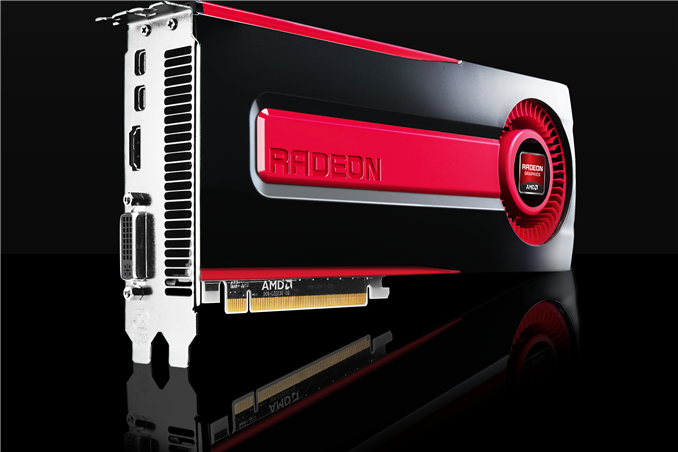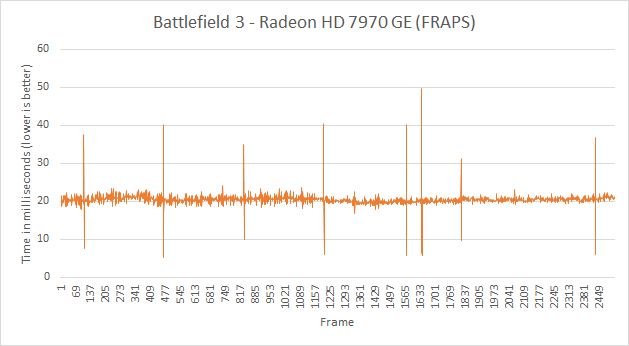AMD Comments on GPU Stuttering, Offers Driver Roadmap & Perspective on Benchmarking
by Ryan Smith on March 26, 2013 2:28 AM EST
For as long as I can remember talking about video cards and GPU performance at AnandTech, there has been debate over the type of benchmarks used to represent that performance. In the old days, the debate was mostly manufacturer driven. Curiously enough, the discourse usually fired up when one manufacturer was at a significant deficit in GPU performance. NVIDIA made a big deal about moving away from timedemos and average frame rates during the early GeForce FX (NV30) days, when its cards might have delivered a decent gaming experience but were slaughtered in most benchmarks. Even Intel advocated for a shift away from most CPU bound gaming benchmarks back during the early years of the Pentium 4 - again, for obvious reasons.
It’s a shame that these revolutions in gaming performance testing were always associated with underperforming products (and later dropped once the product stack improved in the next generation or two). It’s a shame because there has always been merit in introducing additional metrics in order to provide the most complete picture when it came to gaming performance.
The issue lay mostly dormant over the past several years. Every now and then there’d be a new attempt to revolutionize GPU performance testing, but most failed to gain widespread traction for one reason or another. Broad repeatability, one of the basic tenets of the scientific method, was usually cast aside in pursuit of a lot of these new attempts at performance testing - which ultimately limited acceptance.
A year and a half ago, Scott Wasson over at the Tech Report did something no one since Dr. Pabst was able to do: he actually brought about a revolution in the 3D game benchmarking scene.
The approach seemed ridiculously simple - we’ve all had the tools for so very long. Scott used FRAPS to record frame times, and would calculate how long every frame in a benchmark took to render. By focusing on individual frame latencies, Scott’s method could better characterize the little hiccups and stutters that would get smoothed out in an average frame rate. With the new method came a bunch of nifty graphs, and the world changed.

The methodology wasn’t perfect, as FRAPS lacks a holistic view of the 3D rendering pipeline, but it did reveal some surprising issues (in addition to spawning further work that uncovered even more issues on the multi-GPU front). Interestingly enough, many of the issues uncovered by this focus on frame times/latency seemed to primarily impact AMD hardware.
AMD remained curiously quiet as to exactly why its hardware and drivers were so adversely impacted by these new testing methods. While our own foray into evolving GPU testing will come later this week, we had the opportunity to sit down with AMD to understand exactly what’s been going on.
Although neither strictly a defense nor merely an explanation of what we’ve been seeing over the past year, AMD wanted to sit down and better explain their position. This includes both why AMD’s products have been impacted in the manner they were, and why at the same time (and not unlike NVIDIA) AMD is worried about FRAPS being given more weight than it should be. Ultimately AMD believes that it’s to the benefit of buyers and journalists alike to better understand just what is happening, why it’s happening, and just what the most common tools can and are measuring.
What follows is based on our meeting with some of AMD's graphics hardware and driver architects, where they went into depth in all of these issues. In the following pages we’ll get into a high-level explanation of how the Windows rendering pipeline works, why this leads to single-GPU issues, why this leads to multi-GPU issues, and what various tools can measure and see in the rendering process.










103 Comments
View All Comments
Juddog - Tuesday, March 26, 2013 - link
What the hell you talking about? Network latency is an entirely different subject.Juddog - Tuesday, March 26, 2013 - link
I had meant the above as a reply to the guy talking about network fragmentation; I'm not sure why the reply in the new format doesn't auto-nest the response.danielkza - Tuesday, March 26, 2013 - link
Because then the measurement wouldn't be representative of the performance users will actually see?polaco - Tuesday, March 26, 2013 - link
Thanks a lot for this interesting article. Is astonishing to see how minimal software issues can severely degrade performance and efforts done in other areas, turning a company less competitive with the money losses this takes with it.Also is a reminder of how important is to implement deep quality and performance evaluations in software development. Is a shame that in today software industry the delivery dates are more important than quality many times and programmers end up delivering half baked applications from also half baked requirements.
Thanks again.
sudz - Tuesday, March 26, 2013 - link
Good to know I'm not going crazy. Almost every game I play has a decent frame rate, but still doesn't seem smooth. (Gigabyte Windforce 6850 OC) Tried underclocking, overclocking, Different PC's... I thought I had a dud card.DemBones79 - Tuesday, March 26, 2013 - link
Reading through the whole article, I became increasingly convinced that it's not that FRAPS is necessarily a bad tool for measuring this, but that people need guidance in how to interpret the graphs correctly.The first time I saw a frame latency (or whatever you're calling them now) graph, my first impression wasn't, "Wow, look at all these little latency spikes." It was, "Holy sh*t! Look at those huge freaking spikes!" It was a simple matter of severity. I think anyone can take a look at the "heartbeat", see that it is a recurring pattern with a relatively consistent frequency, and- while they may not be able to say for certain if it is indicative of a problem- they can say that it is "normal" for that particular card. It's the huge spikes, the ones that aren't occurring at consistent intervals, that are so much more severe than the "heartbeat", that are the issue.
How hard would it be for a reviewer to draw a pair of horizontal lines across the graph to indicate the limits of "normal" stuttering, where anything beyond the lines in either direction would be considered "abnormal"? A method of separating the signal from the noise.
Furthermore, I thought it was reviewers noticing a difference- that framerate alone couldn't explain- in the way games played between ATI and NVIDIA that prompted the whole investigation into latency. Several sections in the article mention how FRAPS results may not be indicative of user experience. But it was user experience that prompted using FRAPS to try and explain what was being observed.
JPForums - Tuesday, March 26, 2013 - link
Thre are two things you need to keep in mind:1) Nvidia also agrees with the limitation of FRAPS. In fact, IIRC they were the first to voice the issue that FRAPS recordings are in the wrong place and can only infer what actually needs to be recorded. The author is correct, when Ati and Nvidia agree, we should at least pay attention.
2) Though your your points are AFAIK correct and well articulated, they still point to the issue of FRAPS inferring, rather than recording the the targeted information. The difference is, rather than consistency of output frames, you are looking for consistency of simulation steps. I agree that this is a metric that really needs to be covered. In fact, I would even go as far as matching simulation steps to their corresponding frame times to expose issues when short steps are accompanied by long frames or vice versa.
Unfortunately, FRAPS can't measure any of this directly and even for your points proves to be limited to inference. That said, until a reviewer gets tools that can reveal this information, inference via FRAPS is better than no information at all. Pcperspective's comments on AMD's stuttering issues are related (as they state) to crossfire setups. I could see the differences between CF and SLI in blind tests (though SLI also has some microstutter) and this only confirms it. The runt frames only add fuel to the fire. I'm open to using AMD in single GPU builds, but only use Nvidia for multiGPU builds. Perhaps this will change in July, but I'm guessing there will still be plenty of work to do.
JPForums - Tuesday, March 26, 2013 - link
Thre are two things you need to keep in mind:1) Nvidia also agrees with the limitation of FRAPS. In fact, IIRC they were the first to voice the issue that FRAPS recordings are in the wrong place and can only infer what actually needs to be recorded. The author is correct, when Ati and Nvidia agree, we should at least pay attention.
2) Though your your points are AFAIK correct and well articulated, they still point to the issue of FRAPS inferring, rather than recording the the targeted information. The difference is, rather than consistency of output frames, you are looking for consistency of simulation steps. I agree that this is a metric that really needs to be covered. In fact, I would even go as far as matching simulation steps to their corresponding frame times to expose issues when short steps are accompanied by long frames or vice versa.
Unfortunately, FRAPS can't measure any of this directly and even for your points proves to be limited to inference. That said, until a reviewer gets tools that can reveal this information, inference via FRAPS is better than no information at all. Pcperspective's comments on AMD's stuttering issues are related (as they state) to crossfire setups. I could see the differences between CF and SLI in blind tests (though SLI also has some microstutter) and this only confirms it. The runt frames only add fuel to the fire. I'm open to using AMD in single GPU builds, but only use Nvidia for multiGPU builds. Perhaps this will change in July, but I'm guessing there will still be plenty of work to do.
hero1 - Tuesday, March 26, 2013 - link
Long time reader first timer commentor. I really liked this article, and have liked most of the articles here. What I want to say is, I hope that AMD fixes their drivers and address both single and dual gpu issues. I personally didn't have any stuttering when I had 2x7970s but they sometimes lost the link to each other and my system would only see one. I switched to the Titan since I got it for a reasonable price. Now this articles makes me wonder whether I should go back and grab the 2x7970s and save some cash in hopping that AMD has the mutliple GPUs issue solved by early summer. It's good to see them working to address the issue and hope we never have to encounter this again once it's done with. Next step should be how their mutli gpu solutions scale. Thanks Ryan and keep up the good work.Hrel - Tuesday, March 26, 2013 - link
That was a good breakdown of Direct3D. I'd like to see another one for OpenGL if we could. A side by side comparison would be nice.